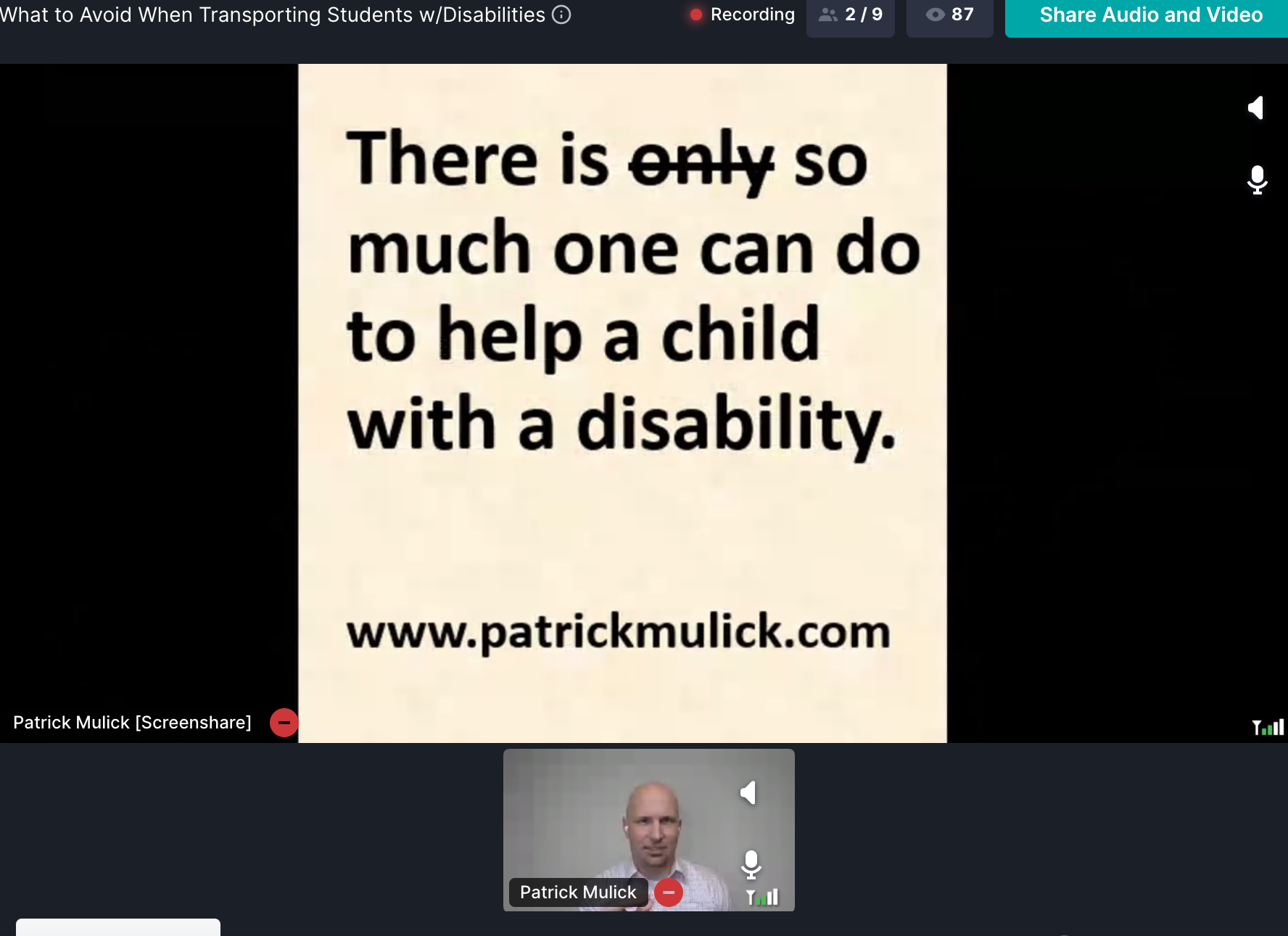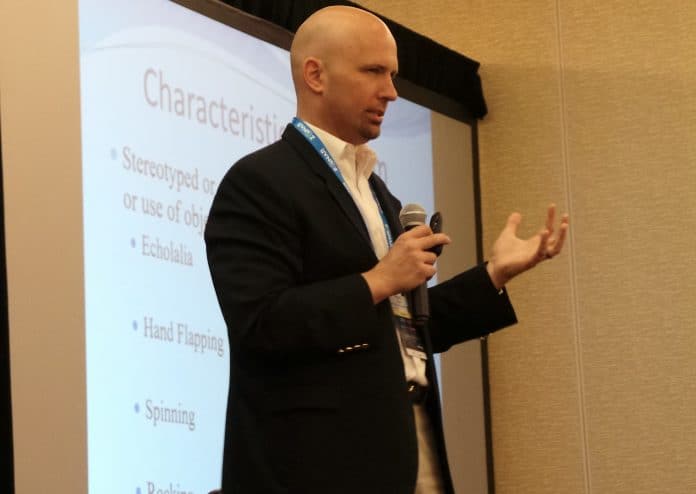Conference fan-favorite Patrick Mulick began his presentation during the TSD Virtual conference on Tuesday with good news, a welcome change from the seemingly constant negatives of 2020.
Mulick, who announced at the TSD Conference last year that he was cancer-free, shocked the crowd again on Tuesday announcing the birth of his now 7-week-old daughter.
As love poured in from the chat comments, Mulick, a board-certified behavior analyst and expert certified speaker, discussed the five assumptions people make when interreacting with students with special needs. These consist of a lack of intelligence, students feel safe when you feel safe, all behaviors can be controlled, parents and teachers lack the interest to collaborate with transportation, and one day you will have it this all figured out.
A Lack of Intelligence
The phrase “Don’t judge a book by its cover” applies to students with disabilities, as their physical appearance could appear one way but it is difficult to understand how the student is thinking or processing internally, Mulick explained. He said as educators, assumptions shouldn’t be made on the student’s level of intelligence.
He said the moment someone treats a student in a particular way, that is what that student becomes. Mulick said Monday’s keynote speaker Temple Grandin benefitted from the support her family provided to achieve greatness, despite being undiagnosed with autism.
He referenced another influential woman, Sady Paulson, who has cerebral palsy and is limited to a wheelchair and nonverbal. Yet he said Paulson was also surrounded by people that believed in her, and while at first glance, one might assume a low intellectual level, she is a professional videographer and has made commercials for the Super Bowl as well as Apple.
Mulick said the biggest disability a student can face is another person’s misconception of them, adding that their confidence gets negatively impacted by the people who don’t believe in them. He advised building up student’s self-esteem, in much the same way Grandin said strengths need to be acknowledged as opposed to student deficits.
He provided suggestions to build students up to their full potential that can be accomplished on a school bus. School bus drivers and monitors, for example, should make an effort to create small talk with their students. Whether the conversation occurs when the bus is moving and students are close enough to interact with, or perhaps while they are loading and unloading the bus, Mulick said transporters need to engage with the students as the human beings they are.
He also said students need to be given the opportunity to be their own person. They shouldn’t be rushed when grabbing a seat inside the school bus and shouldn’t be pushed to grab their belongings quickly and exit when the bus arrives at the student’s stop. He advised giving students time to figure out what they need to do and giving them that responsibility.
Mulick also advised to never talk about a student to another adult in front of the student, which he confessed is something he has been guilty of. He said if you have to talk about the student in front of them, he advised trying to engage the student in the conversation, even if they can only nod in agreement so that the student can feel empowered.
His last advice to give students a voice is to be sure they have a platform in which their voice is being heard. Like with Grandin, Mulick advised student transporters learn a couple of their student’s favorite sign language signs, so they can communicate in that way.
When All is Safe, They Feel Safe
Mulick explained that the perception of safety is relative. He posed questions to the virtual attendees, questioning when or if they would feel comfortable in certain situations. Depending on the person asked and the situation they are in, the answers could change.
He said comfortability changes with different people based on how safe they feel, and their perception of safety in a school bus is based on the students on board. Mulick said students can pick up on things that adults don’t necessarily know about or see. For instance, he said, if a school bus driver or aide is holding a pen, that could set the student off as normally that means someone is getting written up.
Some suggestions he provided to improve the safety of the school bus environment for every student is to:
- Help students to be familiar with the school bus environment.
- Provide accommodations to help students combat triggers.
- Ensure students have a voice.
- Share with students what to expect.
Mulick explained that when a student feels unsafe, everything else can fall apart and their behavior will follow. He explained that sometimes behavior is communication.

Addressing Behavior
Mulick added that while behaviors can’t be controlled, they can be supported. He said student transporters can demonstrate the expected behavior to help students understand what is required of them. In order for a student to meet those expectations, they need to understand what is being asked of them, have the skills necessary to complete it, and have the motivation to do it.
Mulick provided some key points to supporting behavior.
- Establish strong relationships.
- Communicate and enforce expectations and boundaries.
- Learn the basics of how your students communicate.
- Be mindful of what the students can and cannot control.
- Reinforce, reinforce, reinforce
Collaboration Between Transportation, Teachers and Parents
Mulick said educators need to be realistic about what parents and teachers are going through. He explained that it’s not that they don’t want to collaborate but that they either don’t know what transportation does or how to initiate that conversation.
Related: School Bus Driver Training Focuses on Empathy for Students with Disabilities
Related: (Recorded Webinar) Re-engaging Students with Disabilities on the Bus During COVID-19
Related: COVID-19 Adds Challenges to Task of Transporting the Most Vulnerable Passengers
Related: Temple Grandin Shares Expert Perspective on Autism Spectrum During TSD Virtual
Related: Medical Expert Breaks Down Guidance of Transporting Students Amid COVID-19
He encouraged student transporters to start the conversation, and one way to do that is to spread the good word of the students and share their celebrations throughout the departments as well as with their parents at home. He also advised showing appreciation for both the parents and teachers as they will more likely want to collaborate.
One Day You Will Have This All Figured Out
Mulick explained that the best educators are the ones that show up each day ready to learn, adding that transporters are educators too. He said it takes the mindset of educators asking themselves “What else can I do?” instead of settling for the bare minimum.
He said sometimes maybe all that can be done is being done, but he also suggested asking others nearby for help. He said to strive to perform at your highest level and problem-solve for the students being transported.
“Disability is just another form of diversity and we need to make sure we are embracing that,” he concluded.














